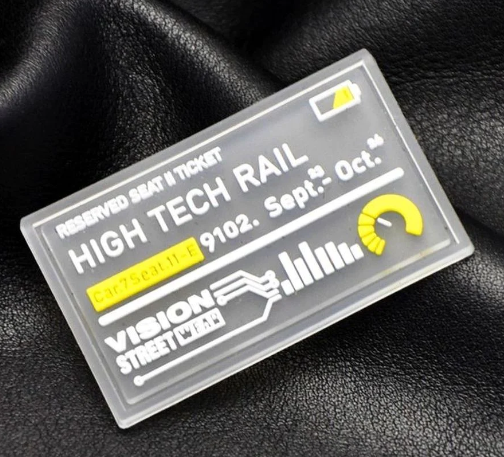Differences and Uniqueness of Rubber Labels Compared to Other Labels
Although the clothing industry generally refers to ‘rubber labels’, these labels are actually made of silicone. Silicone provides a crisp, colourful, wavy, fun, and almost indestructible label.
Table of Contents
ToggleJust like rubber, silicone is waterproof and versatile. Silicone will withstand hot and cold temperatures and does not fade in the sun, that makes it the right labelling selection for extreme sports and industrial products.
Chunky Rubber Labels: The thickness obtained from rubber labels is much richer than woven or even embroidered labels because the labels are much thicker. The thickness of custom silicone labels varies from 1mm to 5mm, the average thickness that each rubber label has or offers.
Clear Rubber Labels: Silicone labels are poured from the mould in Pantone-perfect colours. You get sharp corners on even the most complex letters, so contrasting colours stand out, and logos look pixel-perfect. None of the compromises you’d expect from a fabric label.
Flexible Rubber Labels: Silicone has a little strength inside — it can bend and stretch slightly if you pull/twist it — but will always return to its original shape. This makes it perfect for adhering to advanced textiles such as neoprene and canvas.
Clean Rubber Labels: Inert and odourless silicone. It doesn’t melt, is very hard to scuff, and doesn’t absorb water! Look no further if you’re looking for labels that are physically impossible to bleach or colour!
Durable Rubber Labels: It is difficult to tear silicone labels and they perform very well in extreme temperatures. You can even run the iron over silicone labels without melting or losing details (stay below 220˚C).
Different Rubber Labels: Another great thing about rubber labels is that they are still quite rare! If you are looking for the way to differentiate your whole from anything, rubber labels (or even some promotional badges) will create an enormous impact.
Labels For All Seasons
Rubber labels are an option for tough workwear, industrial and sports fasteners, but you can use them in a variety of situations:
Ski Gear will often use rubber labels for exterior branding compared to fabric labels such as woven or leather label manufacturers. You’ll find lots of salopettes and ski jackets with rubber logos: the logos will still look great after several seasons of sub-zero temperatures, humidity and direct sunlight.
Swimwear also often uses rubber labels. Whether you’re labelling swim trunks or bikini full-body wetsuits, you need a material that can handle the harsh underwater environment. Chlorine and salt water can cause fabric labels to fade over time, so a waterproof silicone solution is perfect for anything swimming-related.
The climbing equipment and strapping industry also use rubber labels. Whether you are a tree surgeon, a dockworker or just someone who likes to go hiking on the weekends, you need to know that your harness will withstand extreme loads. Silicone labels are often visible just above the pop seam (a safety seam that ‘opens’ when your strap is exposed to too much weight) on straps and straps.
Silicone isn’t just for work clothes! Accessories can also look good with rubber labels. In fact, some of our customers compliment their bright wallets and combine them with prominent rubber labels that add texture to the product.
Types of Rubber Labels You Can Get
Because silicone labels are poured into a mould rather than woven on a tiny fabric loom, there’s technically no limit to what you want in terms of shape, depth, and size. The most widely used rubber labels in the categories:
Labels & Tags
A rubber tag on the hem or outside of the neckline can look fantastic if you’re selling sportswear or clothing. Just ensure it’s not in a location where it can rub against the wearer’s skin. The wearer will not have an allergic reaction, but uneven labels can cause irritation.
The best way to attach silicone labels to clothes is to sew them on. Most labels are between 1mm and 5mm thick; If your label is on the thick side, we recommend adding a sewing line. The sewing channel is just a thin border that goes around the label (like a castle trench), giving you a nice thin area to sew the label securely to the fabric.
Badges & Stickers
Silicone can remove heat from the iron without melting (it doesn’t actually melt if you use it with a very hot iron — it just hardens and hardens). This makes it perfect for ironed adhesive backings. If metal isn’t the right choice for your ironing badge, you may find that the silicone option is just what you need.
Peel-and-stick label support is also available for silicone labels. Still, if you work with fabric, we always recommend that our customers choose the sewing or ironing option whenever possible.
Attractive Zipper
Depending on the finish you’re aiming for, a sleek and bright silicone zipper pull could be just what your zipper needs! You don’t need to insert a rubber zipper, and you can reach a thickness of 5mm without a problem. You can also embed the straps and loops directly into the silicone, making the zipper pull secure.
I hope this guide got you excited about rubber labels! Our company, Aseefashion, is engaged in producing various types of labels on a wholesale basis. We have qualified and professional staff to maintain product quality. Don’t hesitate to contact us!

